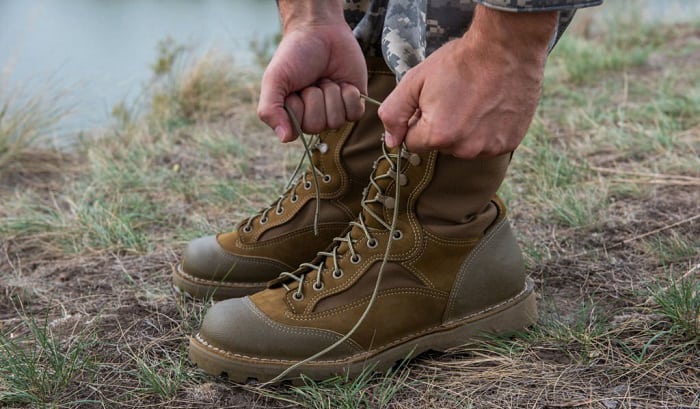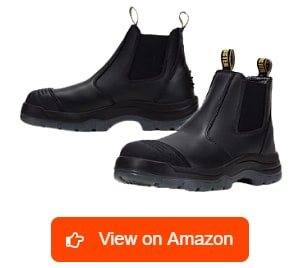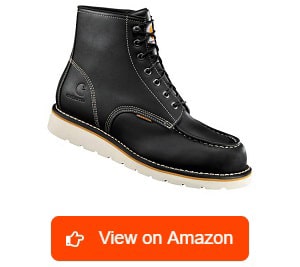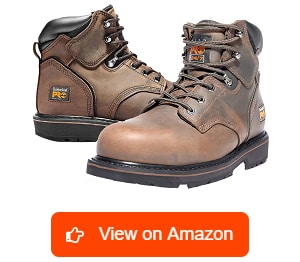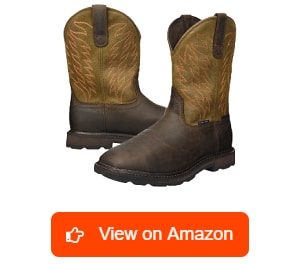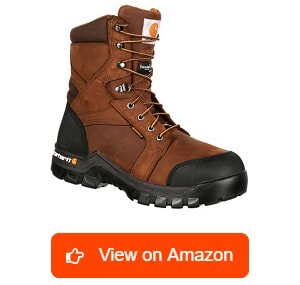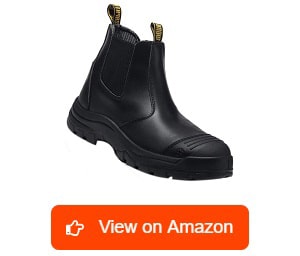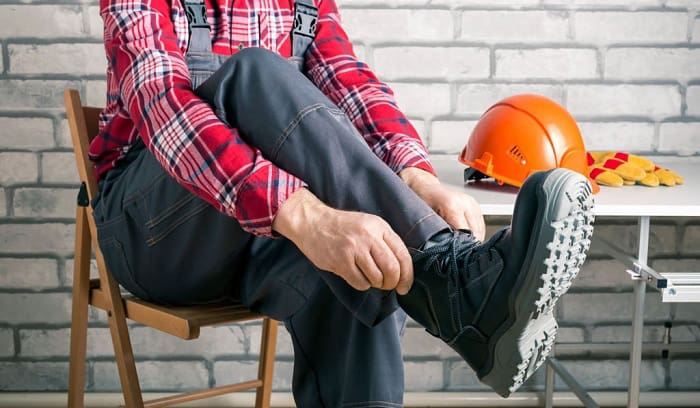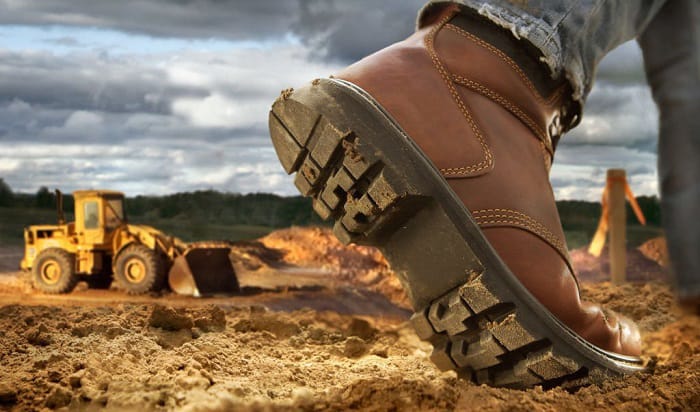Wearing good-fitting boots can reduce the risk of getting calluses, blisters, and other problems.
However, walking into a safety footwear shop can be annoying, only to find that the brand does not offer wide sizes. I can relate to this experience, so I’ve taken the time to research the best work boots for wide feet and share what I learned here.
To help you find the right fit, my advice is to start your search by looking at these components:
- Fit: Because of the toe caps, we can’t buy work boots using the size we have for athletic shoes. Ideally, the work boot should have wiggle room for your toes, and your heels should not shift sideways too much.
Meanwhile, your arch support should align with your arch so your foot can take its natural form. Ill-fitting boots can hurt your toes, give you blisters, and other foot conditions.
- Durability – Full-grain leather is thought to be the most durable upper material you can choose for work shoes. Also, the Goodyear welt construction is the gold standard in shoemaking since it reinforces the structure of the footwear and allows the wearer to resolve it.
- Style: The size and fit vary depending on the brand, country, and style. Lace-up systems let the worker adjust the work boots for a comfier fit, which is not possible with slip-on footwear like Chelseas and Wellingtons.
These types are naturally wider and looser to allow the wearer to slip their feet inside easily, but you can fill up the space with socks.
Below, I’m sharing all the highlights, as well as the pros and cons of each pair of safety boots for wide feet. If you want to look for more options available on the market today, I encourage you to check the Buying Guide to make your shoe shopping quicker and easier.
Table of Contents
Top 6 Work Boots for Wide Feet Reviews
1. ROCKROOSTER Work Boots for Men
Most work boot manufacturers make more regular sizes but ROCKROOSTER is quite the opposite. So far, I think it is the only brand that makes work boots for big feet since all its sizes are extra-wide.
This pair of pull-on work boots for wide feet are a great example. The forefoot and toe box are pretty roomy, allowing my feet to rest naturally.
In harsh conditions, the ASTM-rated steel safety toe caps and static dissipative design protect my feet. Besides construction work, these are comfortable work boots for welders and warehouse workers.
For outdoor use, I rely on them to repel the water while simultaneously promoting good ventilation to prevent my tootsies from sweating excessively.
Furthermore, the durable full grain leather has already been softened during the manufacturing so I didn’t have to break in these boots. To add to the comfort, they include footbeds made with anti-fatigue technology. As such, my feet do not feel sore after a long shift.
- All sizes are extra-wide for wide feet
- ASTM-rated steel safety toe caps and static dissipative design
- Apt for welders and warehouse workers
- Repels the water while simultaneously promoting good ventilation
- No need to break into these boots
- Has footbeds made with anti-fatigue technology
- Does not support the ankles well
2. Carhartt Waterproof Soft Toe Wedge Boot
The main highlight of these boots, according to most users, is the Storm Defender waterproof breathable membrane and FastDry lining. True to its promise, my feet stayed dry and sweat-free regardless of the weather. Besides, I love how the pair’s stylish look and various nice colors suit formal meetings.
On top of that, this pair also offers electrical hazard protection. For technicians who do not need safety toes, this footwear is just right.
In my case, I wear these boots whether on project sites or in the office. Though this model is available in wide sizes, the moc toe design is more spacious than the plain toe.
What’s more, these boots have comfort features like removable insoles made of PU foam and dual-density rubber outsoles. Even if I’m walking and standing all day, they absorb the shock and support my feet.
I recommend these work boots for flat wide feet. Since the wedge sole’s entire surface touches the ground, it distributes the pressure more evenly.
- The Storm Defender waterproof breathable membrane keeps the feet dry
- FastDry lining for sweat-free wear regardless of the weather
- Available in multiple colors with a nice design
- Absorbs the shock and supports the feet
- Built with Goodyear welt construction
- Moc toe pairs have spacious toe room for comfort
- Missing finger loop at the back
- The shoelaces are notnthat durable
3. Timberland PRO Men’s Pit Boss 6″ Steel Toe Work Boot
This pair of safety steel-toe boots for wide feet complete my protective equipment set! I’m happy to report that this particular model offers asymmetrical toe caps for a more custom fit. Best of all, this design is available in regular sizes and wide widths. Even so, the interiors are spacious, allowing my tootsies to relax.
Beyond that, these boots also provide electrical hazard protection, as well as oil-, heat-, abrasion-, and slip-resistant outsole. I can walk on debris, oily concrete surfaces, or the roof without losing my footing. This feature can also be useful for construction workers, roofers, and mechanics.
Speaking from experience, these work boots are my solution for sore feet. It helps that the outsole is equipped with a shock diffusion plate. Apart from supporting the boot’s structure, it also distributes the impact more evenly.
Meanwhile, the interiors of the upper are lined with moisture-wicking material with antimicrobial treatment, which aids me in fighting odor.
Let me also add that the nubuck leather is tough, which ensures durability. My only gripe, however, is that they take some time to soften up.
- Offers asymmetrical steel toe
- Available in regular sizes and wide widths
- Useful for construction workers, roofers, and mechanics
- Equipped with a shock diffusion plate
- Has moisture-wicking material with antimicrobial treatment
- Made of tough nubuck leather
- Take some time to break in
- The padded collar can rub the skin during the break-in period
4. ARIAT Groundbreaker Waterproof Steel Toe Work Boot
Generally, ARIAT’s sizes run a bit larger than other brands, which is why I’m including these cowboy boots here. Another fun fact: Square toes are roomier than plain or pointed toes, and therefore more suitable for extra wide feet.
Because they allow my toes to spread naturally, I also find them comfier for standing and walking for prolonged periods.
Admittedly, I’m fascinated by this brand’s ability to infuse modern safety features with its line of timeless cowboy boot styles. This one has a steel toe, electrical hazard protection, a lightweight stabilizing shank, and a durable oil- and slip-resistant Duratread sole.
With that, I think these are the best work boots for farm, ranch, construction, and warehouse workers.
I depend on them to keep my feet dry in wet conditions and warm during mildly cool weather. All this is made possible by its Waterproof Pro construction.
Given that shafts are decorated with beautiful stitching patterns, these aren’t just work boots for wide feet but also a fashion statement. Also, they score high in durability knowing that mine last year!
- Comfortable men’s wide work boots
- Keeps the feet dry in wet conditions and warm during mildly cool weather
- Cowboy boot style decorated with beautiful stitching patterns
- Has a steel toe for electrical hazard protection
- A lightweight stabilizing shank
- Features a durable oil- and slip-resistant Duratread sole
- The breathability is not the best due to its watertight design
5. Carhartt Men’s Rugged Flex Safety Toe Boot
When it comes to extra wide composite toe work boots, this pair from Carhartt outperforms them all!
This is a bold claim. Yet, it truly reflects the comfort and safety that it provides for the workers who toil away in the coldest days of winter. With 400g 3M Thinsulate and Storm Defender, my feet are always warm and dry.
The composite toe meets the ASTM standards, making them effective in safeguarding my feet against the impact of falling objects. Another advantage is that the non-metallic material ensures that the boot does not make my feet feel cold nor conduct electricity.
Hence, this type of footwear is apt for most industrial work, like construction and landscaping.
Since I’m constantly on my feet, the EVA midsole and PU cushioned insole are the two other reasons why I choose to wear these boots. Together, they absorb the shock in each step, minimize the pressure, and in turn, reduce fatigue. I also think that the rubber toe and heel bumper keep me stable.
- Comes with 400g 3M Thinsulate and Storm Defender
- Has composite toe that meets the ASTM standards
- Absorbs the shock in each step, minimizes the pressure and reduces fatigue
- Has Rugged Flex outsole offers maximum traction
- Apt for most industrial work, like construction and landscaping
- Breaking these boots take a while
6. DIIG Work Boots for Men
Pull-on boot styles, as I said, are generally suitable for wide feet even without extra wide sizes. But to be clear, this one is offered in standard and wide.
As one of the most versatile boots on my shoe rack, I can wear them throughout the four seasons. Thanks to COOLMAX fiber technology, my feet can stay dry when working on wet grounds.
Yet, this lining is also breathable, which helps prevent odor and sweat. For an affordable brand, DIIG packs this boot with a hard-wearing steel toe and puncture-resistant KEVLAR midsole for underfoot protection. It also boasts a static dissipative feature, which is why it’s perfect for construction workers and technicians.
Even more impressive, the manufacturer did not cut corners in materials and construction to ensure the boot lasts long. This is probably the cheapest footwear I’ve had that’s made of full-grain leather and built with the Goodyear welt method!
With the elasticated gusset and pull tabs at the back and front, I can pull the boots easily when I need to put them on.
- Can be worn throughout the four seasons
- Has a breathable lining that helps prevent odor and sweat
- Has puncture-resistant KEVLAR midsole for underfoot protection
- Perfect for construction workers and technicians
- The materials and construction ensure the boot lasts long
- Reliable for most terrains and indoor surfaces
- The upper sometimes rub the skin
What Are Work Boots for Wide Feet
Essentially, wide-fit work boots are designed to accommodate workers with wide feet. Their functionality remains the same: They offer tough protection, comfort, and support.
The only difference is that work boots for wide feet are the size and fit. Most boot companies offer wide sizes, using letters to indicate the width:
- A: ‘A’ refers to narrow or extra narrow for women and extra narrow for men. The more As or the larger the number attached to it, the narrower the shoes.
- B: For women, ’B’ is the ‘standard’ or ‘medium’ width but for men, it’s a narrow width.
- D: ‘D’ is considered the ‘standard’ or ‘medium’ for men but this letter stands for wide feet women’s shoes.
- E: E is the widest but adding more Es or digits next to it means that the width is increased. For instance, 6E wide steel toe work boots are wider than 3E wide work boots. For women, 2E is considered extra wide.
Types of Work Boots for Wide Feet
Fortunately, most work boots are available in wide and extra wide sizes. Here are some of the styles that you can check out:
- Safety work boots
- Soft toe work boots
- Logger boots
- Hiking boots
- Moc toe boots
- Chelsea boots
- Wellington boots
Why Do You Need Work Boots for Wide Feet
Forcing your feet into tight-fitting shoes prevents them from resting in their natural form and position.
Discomfort should be the least of your concerns—there are far worse consequences that one can suffer from wearing tight shoes.
Besides restricting your movement and blood flow, wearing tight shoes can lead to swelling, toenail infection, hammer toe, bone deformity, and joint inflammation.
Buying Guide
Choosing wide-width work boots is not just about choosing sizes. Rather, it’s a process that involves considering other factors like usage, protective features, weatherproofing, comfort, and budget that influence our choices. Let’s talk about:
- Usage
Choosing between moc toes vs. Plain toes, heel vs. wedge soles, and pull-on vs. lace-up is not just about fashion trends.
These styles are designed to help specific types of workers perform better in certain jobs or environments.
- Pull-on boots are wide by default compared to lace-up, but they are intended for workers who frequently need to change footwear.
- The same logic applies to heels vs. wedge soles. Since the wedge sole’s entire length touches the ground, it is comfier for workers who need to stand and walk all day long.
- Heeled soles offer better traction, which makes them suitable for outdoors or slippery surfaces. Just the same, between moc toe and plain toe, the former offers more space to accommodate more diverse foot shapes.
- Comfort
The whole point of buying boots is so that our wide feet will never get injured or deformed. When checking the features, however, it’s also important to take into account our socks or orthotics for those who have fallen arches or other conditions. After all, these garments and devices are not ‘optional’—they are part of our everyday work attire.
Typically, work boots are also equipped with comfort features like EVA midsoles for better shock absorption. Meanwhile, work boots with full-grain leather uppers and tough rubber outsoles can take a while to break in. But rest assured, these materials will stretch and get comfier eventually.
- Durability
Not all extra-wide work boots manufacturers use durable materials for shoe making techniques that allow the footwear to last longer. If you don’t know anything about construction methods or upper materials, then it can be challenging to determine whether the boots can stand the test of time.
To date, full-grain leather is considered the most durable upper material. Meanwhile, Goodyear welt construction is the gold standard in shoemaking as it strengthens the footwear’s structure and allows the wearer to resole. It’s something you can’t do with cement construction, which is a method that involves sticking the upper to the sole.
But regardless of the construction or material, any boot can last years if you maintain them properly!
- Protection
Your company’s safety officer or your boss should inform you of the risks that workers face while on the job, as well as the required personal protective equipment.
In some cases, the employer would provide company-issued PPEs but if you have to buy your own, make sure that the work boots have all the protective features to help you work safely.
Either way, be sure that the safety features like steel toe, slip-resistant sole, or electrical hazard protection meet the ASTM standards.
- Weatherproof
Whether you work during the summer, winter, or every month of the year, your work boots should be able to protect you against the elements. At the same time, they should also “breathe” and help you avoid drenching your tootsies in your sweat.
Manufacturers have developed materials like thermal insulation and waterproof membrane to keep the boots lightweight. Some boots are water-resistant while others are watertight. This does not mean that one is better than the other. It’s up to you to figure out which one suits your job the most.
Care and Maintenance
Finding safety boots for extra wide feet is hard so take the time to keep them in good shape. Doing so will not only ensure that the leather upper is supple but also prolongs the lifespan of your work boots.
At the end of each shift, brush off superficial dirt after each shift. Next, use a damp cloth to wipe the work boots and allow them to air dry. As for soiled boots, follow these steps:
- Start by taking out the laces and footbeds and removing the gunk with an old toothbrush or shoebrush.
- Get your saddle soap and create a lather by adding a small amount of water. Spread the lather across the surface with a cloth.
- Use mild shampoo and a damp cloth to clean the insides of the boots.
- Rinse them afterward with water, and allow your boots to air dry.
- Your insoles and laces should be hand-washed with mild shampoo or detergent. Alternatively, you can put them in the washing machine.
When not in use, place your boots in a dry location and away from a heat source like the sun. Sprinkle some baking soda inside your boots to prevent odors.
Frequently Asked Questions
What’s the widest boot you can get?
For the wide option, most work boots are usually available in E, EE, and EEE. However, some brands also offer EEEEEE or 6E.
Should you buy a size bigger in work boots?
This will depend on the boot design and brand. As mentioned previously, each shoe company has its sizing convention.
Keep in mind that steel-toe boots are often paired with thick socks as they serve as additional padding and prevent the toes from rubbing against the toe box. Ideally, your feet should feel comfy when standing, walking, and performing different tasks for long periods.
Ordering one size up is advisable for those who are in between sizes. However, if the boots lack width, do not order one size up in standard boot sizes. While wearing a bigger size may address the lack of width, the work boots will also be too long. This, too, will cause blisters and heel slippage.
How do I know if I need a wide work boot?
One way to find out that you need boots with wide widths is to see if your toes curl inside. It’s also true if your foot exceeds 9 inches (23 cm) wide or if you wear size 9 shoes and more.
But it shouldn’t have to be this way since there’s a proper way to do it: Measuring your feet.
- You can trace your feet on paper and then stick a ruler on the broadest part of each foot to get the width.
- For the length, measure the distance between the heel and the longest toe.
- Don’t forget to write the measurements on a piece of paper. When you go shoe-shopping, you can use these as references, especially when checking the brand’s size charts on the website.
Make it a habit to do this whenever you buy a new pair of wide-toe box work boots. You may not notice it but the shape of your feet evolves. Some people have really wide feet but aging, health conditions, and pregnancies can enlarge the feet.
Also, some folks develop bunions, club feet, and other foot deformities that prompt them to buy new work shoes for wide feet.
What’s the difference between regular and wide boots?
Generally speaking, regular and wide work boots have the same features and the same length. The difference is that the wide-fitting boots have more room at the toe box and greater depth.
Conclusion
Most shoe brands provide a wide option for the same model. Yet, finding the best work boots for wide feet remains a challenge because manufacturers do not follow the same sizing convention. To complicate things more, our feet change in shape over time.
Apart from sharing a buying guide, I reviewed six work boots with wide toe box that cater to different budgets. While bigger sizes do not necessarily incur an extra cost, I also made sure that you, my readers, get to pick boots that perform well regardless of price and size.

Veronica is our content editor. She is a talent in delivery. Her main work is editing and writing articles that are both informative and simple to follow. She is in charge of synthesizing our understanding of what personal protection equipment (PPE) is needed in each job, how to best apply it, and how to visualize that equipment.


